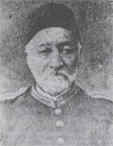Tanburi Büyük Osman Bey facts for kids
Quick facts for kids
Tanburi Büyük Osman Bey
|
|
|---|---|
 |
|
| Background information | |
| Born | 1816 Istanbul, Ottoman Empire |
| Died | 1885 (aged 69) Istanbul, Ottoman Empire |
| Genres | Ottoman classical music |
| Occupation(s) | composer, tanburi |
| Instruments | tanbur |
Tanburi Büyük Osman Bey (born in 1816, died in 1885) was a famous musician and composer from the Ottoman Empire. He played the tanbur, a stringed instrument similar to a long-necked lute. He is known as one of the best composers of peşrevs, which are special instrumental pieces in Ottoman classical music.
Life of a Master Musician
Tanburi Büyük Osman Bey was born in 1816 in Tophane, a part of Istanbul, a big city in the Ottoman Empire. Most of what we know about him comes from stories passed down by his students and their students. His father, Zeki Mehmed Ağa, and his grandfather, Tanburi Numan Ağa, were also well-known musicians.
When he was eight years old, Osman Bey was accepted into the Imperial School of Enderun. This was a special school where he learned from the best teachers of Turkish classical music. Here, he built a strong understanding of music theory. This is also where he first learned to play the tanbur.
His father, Zeki Mehmed Ağa, didn't want to teach him the tanbur. So, Osman Bey had to learn most of it by himself. He also performed in musical gatherings called fasıls with famous singers like Rifat Bey and Haşim Bey. This helped him improve his singing skills.
After his father passed away, Osman Bey stopped singing and focused only on his tanbur. He played in "incesaz fasılları" (small instrumental music gatherings) at the court of Sultan Abdülaziz Han. Many of his best compositions were created during this time. He was also very interested in the teachings of Mevlana Djelaleddin Rumi, a famous poet and mystic. Because of this, he often visited mevlevihanes, which are places where followers of Rumi gather, especially the Kulekapısı Mevlevihanesi on Fridays.
Osman Bey was known for being very particular about music being played correctly. There's a story that he once got upset when a kanuni (a player of the qanun, a stringed instrument) played a wrong note during one of his pieces.
In 1885, he passed away from a lung illness he had for a long time. He was buried in the cemetery of the Yahya Efendi Dergâhı in Istanbul. He had three sons and one daughter.
His Musical Works
As a composer, Tanburi Büyük Osman Bey was especially good at creating peşrevs. These are important instrumental pieces in Ottoman classical music. His music style was quite simple and clear. He avoided sudden changes, which made his peşrevs feel balanced and light.
Many of his peşrevs use a rhythmic pattern called devr-i kebir. His works are easy to tell apart from older composers' music. The only older peşrev composer he really admired was Gazi Giray Han. Osman Bey called Gazi Giray Han's "Hüzzam Peşrevi" a "sehl-i mümtenî," which means "a simple work done with great skill" or "a piece of a jewel."
For a long time, Osman Bey didn't want to compose a peşrev in the same musical style (maqam) as Gazi Giray Han's "Hüzzam Peşrevi" for the Mevlevi order's musical ceremonies. But eventually, the leader of the Galata Mevlevi Monastery, Atâullah Efendi, convinced him. So, he composed his own famous hüzzam peşrevi. This piece is still often played during Mevlevi ceremonies today.
Tanburi Büyük Osman Bey composed many pieces, including various peşrevs, instrumental pieces called Saz Semais, and vocal songs called Şarkıs.

